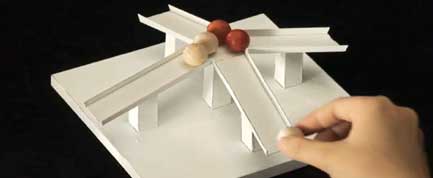Best Visual Illusion Of 2010 Defies Gravity

WASHINGTON (ISNS) -- On May 10, Japanese scientist Kokichi Sugihara claimed to have discovered a technology that every sixth grader knows to be impossible: a magnet that attracts wood. In front of a crowd of hundreds, he played a video showing four wooden balls rolling up four ramps, supposedly pulled uphill by his new super-magnet.
The audience clapped and cheered, but no one believed that magnets were behind the gravity-defying demonstration.
That's because Sugihara and others were showing off the latest in visual illusions -- designed to trick the mind into seeing the impossible -- during the 6th annual Best Illusion of the Year contest at the Philharmonic Center for the Arts in Naples, Fla.
Sugihara's clever arrangement of wooden ramps and balls won first place, beating out the other 83 contestants.
The event, which takes place at a meeting of the Vision Sciences Society, draws artists and researchers who study the mental gymnastics our brains perform to make sense of what our eyes see. The participants gather annually to pick and learn from the new illusions produced that year.
{{ video="LS_100512_RampIllusion" title="Balls Appear to Roll Uphill in Best Illusion of 2010" caption="Japanese scientist Kokichi Sugihara’s clever arrangement of wooden ramps and balls won first place in the 6th annual Best Illusion of the Year contest. Credit: ISNS" }}
Sugihara created his illusion with a computer program that tested what different arrangements of ramps would look like from different angles. The final cross-shaped pattern contained four ramps of different length that obviously slope downwards towards the center from every viewpoint except one. From just the right angle, though, the mind decides that it is simpler to see four ramps of equal length rising towards the center.
Sign up for the Live Science daily newsletter now
Get the world’s most fascinating discoveries delivered straight to your inbox.
"We prefer to see rectangular shapes," said Sugihara of the Meiji Institute for Advanced Study of Mathematical Sciences in Kawasaki, Japan.
Daniel Simons of the University of Illinois at Urbana-Champaign dressed up for the occasion, showing a video of himself in a gorilla suit to demonstrate the limits of what we are able to notice in our surroundings. He revisited an experiment from six years ago that asks spectators to count the number of times basketball players pass the ball. About half of people who watch this video fail to notice a gorilla walking through the middle of the game.
But this time, Simons warned the crowd ahead of time. Expecting the unexpected, they spotted the gorilla but missed other changes in the scene: color-changing curtains, basketball players walking away from the game, and a man dressed as a pirate.
Many of the illusions revealed distortions in what we see based on our previous experiences.
Billboard ads, for example, can appear 3-dimensional without the aid of 3-D glasses, according to finalist Lydia Manitis of American University in Washington, D.C. A photo of bath tub seemed to stretch and shrink as she walked at a close distance with a video camera. It changed shape and size in the same way that an actual tub in an actual bathroom would to reflect a change in perspective.
Peter Thompson, a psychologist at the University of York, U.K., showed that people look skinnier when standing on their heads. In his illusion, a face turned upside-down -- or a face with just the eyes and mouth turned upside-down -- looks narrower because of the way we pay attention to facial features.
Second place went to Bart Anderson of the University of Sidney, Australia, for an animation in which a square seems to appear on top of circles moving back and forth -- a ghost produced by the brain's attempts to solve what it sees.
The winners' trophies, sculptures created by Italian artist Guido Moretti, are themselves visual illusions that change shape depending on the angle from which they are viewed.
To see all of the other finalists, visit the Neural Correlate Society's website.









